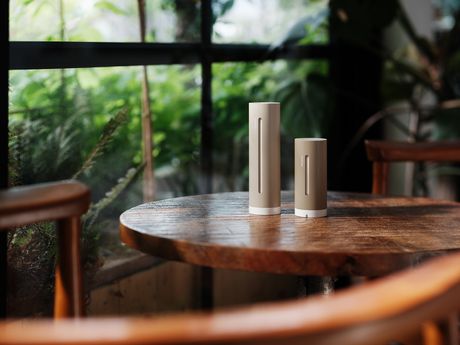
Netatmo präsentiert die Wetter Station ORIGINAL

Bis zu -50 % auf eine Auswahl an ProduktenKaufen

Die Dachbodendämmung ist eine Lösung, die gleichzeitig thermisch (bessere Wärmequalität), wirtschaftlich (Heizkostenreduzierung um 30 %) und ökologisch (im Sinne der Energiewende und Energieeinsparung) ist. Dies ist der erste Schritt zur energetischen Sanierung Ihres Hauses.
Die Investition in ein Heizsystem mit hoher thermischer Leistung, das mit einem programmierbaren Thermostat kann Ihnen helfen, Energie und Geld zu sparen. Aber wenn die Wärme durch den Dachboden und das Dach entweicht, ist dies trotz allem eine riesige Verschwendung von Energie und Geld!
Wussten Sie, dass das Dach für bis zu 30 % der Wärmeverluste eines Hauses verantwortlich ist? Dies ist keineswegs unbedeutend. Die Dämmung Ihres Dachbodens und des Daches Ihres Hauses ist daher nicht nur eine energetische Sanierungsmaßnahme unter vielen: Sie hat Priorität.
Ist es in Ihrer Gegend heiß? Das ist keine Ausrede, Dämmung ist für die Wärme fast genauso wichtig wie gegen Kälte!
Hier sollten Sie ansetzen, wenn Sie energetische Sanierungen in Ihrem Haus durchführen wollen. Sobald diese Isolierung erreicht ist, werden alle nachfolgenden Investitionen an Effizienz und Rentabilität gewinnen.
Unabhängig davon, ob Sie einen ausgebauten Dachboden oder einen unbewohnbaren Dachboden haben, sind die Dämmtechniken nicht die gleichen. Beachten Sie, dass die Dachbodendämmung in allen Fällen am häufigsten von innen vorgenommen wird.
Wenn Sie Ihren Dachboden gedämmt haben, bringen Sie Ihre energetische Sanierung auf die nächste Stufe. Reduzieren Sie Ihre Energierechnung noch weiter durch die Installation eines smarten Themotstats von Netatmo an Ihrer Zentralheizungsanlage! Damit können Sie Ihre Heizkörper aus der Ferne und in aller Ruhe steuern und programmieren, um Ihre Energieeffizienz zu verbessern.
Was die Dämmung Ihres ausgebauten oder verlorenen Dachbodens betrifft, haben Sie die Qual der Wahl. Dies ist viel zu umfangreich, um alle Angebote zu vergleichen. Geben Sie einfach Ihre Anfrage bei Google ein und Sie erhalten etliche kommerzielle Vorschläge: Es ist ein boomender Markt. Und das aus gutem Grund: Die Energiewende ist in vollem Gange und die Handouts dürfen nicht fehlen. Wir werden am Ende des Artikels darauf zurückkommen.
Wichtig ist also, dass Sie Ihre Dämmung entsprechend Ihren Anforderungen und Ihrem Dach auswählen. Zunächst ist zu beachten, dass es auch viele Hochleistungsisolatoren gibt: pflanzlichen, tierischen oder mineralischen Ursprungs, deren Preis-Qualitäts-Verhältnis variiert. Die am weitesten verbreitete Dämmung ist jedoch nach wie vor Glaswolle, mit der mehr als 70 % der deutschen Häuser gedämmt werden.
Zu den anderen großen Dachbodendämmungen gehören vor allem:
Eine Dachbodendämmung erfordert keine großen Installationsarbeiten. Passen Sie die Dämmung einfach an das Dach an. Das ist die Hauptschwierigkeit, oder besser gesagt, das Hauptelement, welches Sie berücksichtigen müssen: Die Art und Form des Daches. Abhängig von diesem Typen wählen Sie Rollen, Platten oder Schüttgut.
Die Preise für die Dachbodendämmung (Arbeit und Dämmung) variieren je nach Unternehmen, Art der Dämmung und der zu dämmenden Fläche. Es hängt also alles von Ihren Zielen ab, aber in den meisten Fällen wollen Sie eine maximale Energieeinsparung zum attraktivsten Preis erreichen.
Im Durchschnitt können Sie in Deutschland mit einem Preis von etwa 20 bis 50 €/m² für die Dämmung des Dachbodens eines Hauses rechnen, während die Spanne für den Ausbau des Dachbodens bei 40 bis 270 €/m² liegt.
Es ist auch wichtig zu wissen, dass sich dieser Preis schnell bezahlt macht, denn die Einsparungen sind sehr wichtig, zumal 4 finanzielle Hilfen den Preis der Arbeit reduzieren können. In fünf Jahren ist es durchaus möglich, dass sich die Dämmung Ihres Dachgeschosses, ob ausgebaut oder nicht, rentiert.
Zum einen ist da die Steuergutschrift, was Ihnen einen deutlichen Schub für Ihre energetischen Sanierungsarbeiten, einschließlich Dachbodendämmung, geben kann. Somit ist dies geeignet für die Wärmedämmung des Daches, aber nicht nur: auch niedrige Böden, Wände oder blickdichte Wände sind betroffen. Um gefördert zu werden muss man jedoch verschiedene Kriterien erfüllen. :
Dann können Sie mit dem Öko-Kredit zum Nulltarif, wie der Name schon sagt, bis zu 30.000 € zum Nulltarif für die Wärmedämmung Ihres Dachgeschosses leihen.
Nicht zu vergessen der Energie-Solidaritätspakt, eine finanzielle Unterstützung für die Dämmung des verlorenen Dachbodens mit 1 Euro für 70 m² und 10 Euro für jeden weiteren m². Achten Sie jedoch darauf, die Verkaufsbedingungen sorgfältig zu analysieren und nicht auf Betrügereien hereinzufallen, die bei dieser Art von Arbeit häufig vorkommen.
Schließlich ist es unmöglich, die lokalen und regionalen Beihilfen für die Dämmung Ihres Dachbodens nicht zu erwähnen. Um alle zu erfahren, wenden Sie sich direkt an Ihr Rathaus.
Die Dachbodendämmung ist ein energetisches Muss. Wenn Sie Ihre Energie- und Heizkostenrechnung zum Schmelzen bringen wollen, sind dies die ersten Arbeiten, die zu erledigen sind. Durch die finanziellen Unterstützungen ist es eine sehr profitable Wahl!